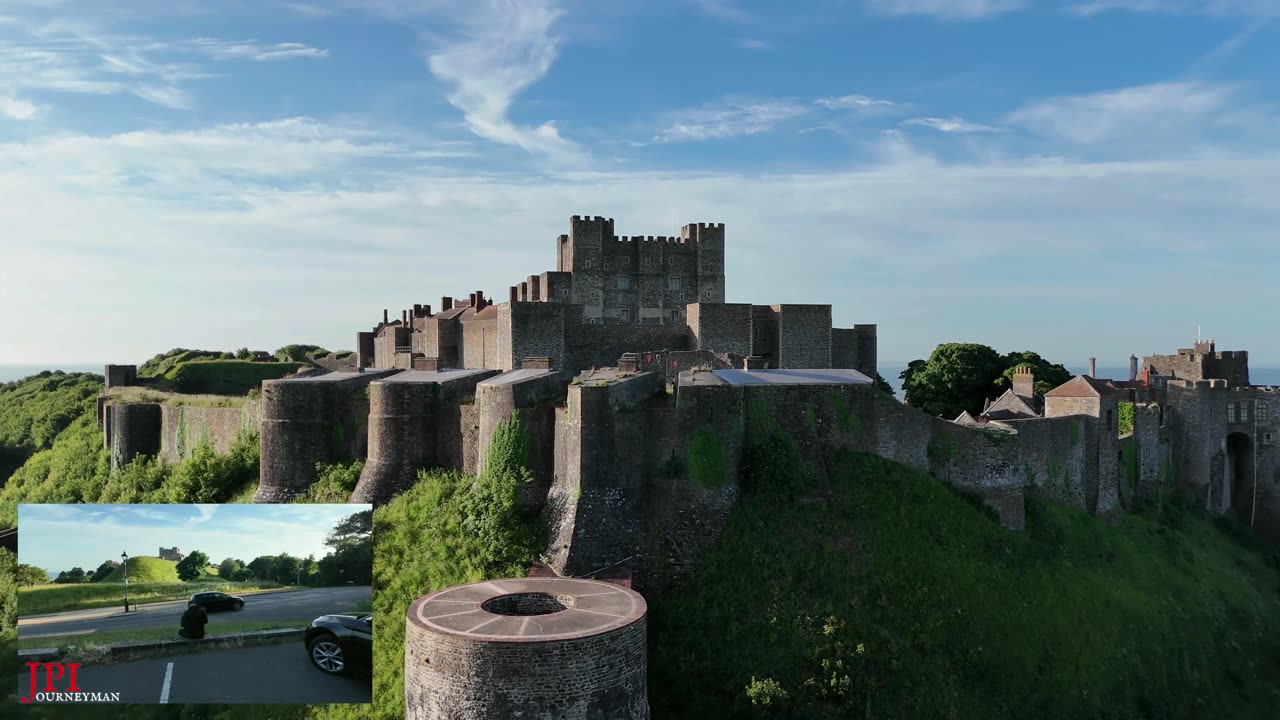Premium Only Content

July 1, 2024
Dover Castle, located in the English county of Kent, sits on top of the famous White Cliffs of Dover. It is one of the most iconic and historically significant fortifications in the country. The castle has served as a symbol of England's strength and resilience throughout the centuries, standing guard over the narrowest point of the English Channel, a spectacular vantage point for any castle, serving as a vital line of defence against foreign invaders.
Introduction To Dover Castle
The castle's history can be traced back to the Roman era, when it was used as a lighthouse to guide ships into the English Channel. However, it was during the Middle Ages that the castle truly came into its own, playing a key role in the country's political and military landscape.
Over the centuries, Dover Castle has undergone many changes, with each new owner adding their own architectural and strategic improvements to the fortress. Despite this, the castle remains one of the best-preserved medieval fortresses in England, and is now a popular tourist attraction, attracting visitors from all over the world who are eager to learn more about its rich history.
The Early History Of Dover Castle
The earliest recorded history of Dover Castle dates back to the Iron Age, where it is believed that a hill fort was constructed on the site. This hill fort was later occupied by the Romans, who used it as a lighthouse, known as the Pharos, and military fortress to control the surrounding area and ensure the security of their supply routes. The lighthouse was one of the tallest in the Roman world and could be seen for miles around, making it an important landmark for ships approaching England.
The castle's strategic location made it a target for invading forces, and it was destroyed by Germanic tribes during the 5th century. However, the castle was soon rebuilt, and by the 11th century, it had become a significant military stronghold, guarding the entrance to the English Channel.
Dover Castle’s Medieval History
During the Norman Conquest, William the Conqueror ordered the construction of a wooden motte and bailey castle on the site, replacing an old Anglo-Saxon fortified church and settlement. This was later replaced by a stone structure. Under the rule of King Henry II, the castle was extensively renovated and expanded, becoming one of the most powerful fortifications in England.
Dover Castle has always been seen as the Key to England because of its prominent, defensive position and significance. It is also the largest of all the English castles. It's great keep is one of the last ever rectangular keeps to be built, and the man responsible for building it was Maurice the Engineer, who built Castle Garth amongst others. Dover Castle was a symbol of power and an opposing monument to any foreign visitors, but it was also a palace designed for royal ceremonies, housing Henry II's court.
The Middle Ages were a time of great political and military upheaval in England, and Dover Castle was at the centre of much of this activity. Throughout the 11th and 12th centuries, the castle was a focal point for military campaigns, with England's rulers using it as a base from which to launch attacks on their enemies.
One of the most notable events in the castle's history was the siege of 1216, when King John was forced to flee to the castle to escape the advancing army of Prince Louis VIII of France, during the First Baron's War of 1215-1217. Despite the castle's impressive defences, Prince Louis was able to lay siege to the fortress, and it was only through the intervention of the English navy that King John was able to hold out until reinforcements arrived.
The castle was never taken, but during the siege, Henry's men dug tunnels underneath and out of the castle towards the rebels and the French. There they successfully attacked the rebel army, in the only counter-attack tunnel in the world. These tunnels were later re-used during the second world war as converted air raid shelters and later as a military command centre.
The castle was also used as a prison for important political figures during this time, including William the Conqueror's half-brother, Odo, who was imprisoned there in the 11th century. The castle was also used as a royal palace, with King Henry II and his wife, Queen Eleanor of Aquitaine, using it as a residence during their reign.
The location of Dover Castle made it possible for visiting nobles to travel on a short pilgrimage to the new shrine of St. Thomas Becket, in Canterbury Cathedral. A place where Thomas was brutally murdered before the altar by Henry's knights in 1170. He was once a close friend of the king, however things turned ugly and Thomas paid the price with his life. Henry, who perhaps was feeling rather guilty about the Archbishop's murder, repaid his penance by walking into Canterbury Cathedral and demanded to be flogged by the monks there.
-
![PROSECUTOR PIRRO: Massive Drug Seizure Exposes China-Cartel Precursor Chemical Route [EP 4704]](https://1a-1791.com/video/fww1/c2/s8/1/O/H/Y/e/OHYez.0kob.2-small-PROSECUTOR-PIRRO-Massive-Dr.jpg) LIVE
LIVE
The Pete Santilli Show
1 hour agoPROSECUTOR PIRRO: Massive Drug Seizure Exposes China-Cartel Precursor Chemical Route [EP 4704]
101 watching -
 1:09:48
1:09:48
Kim Iversen
3 hours agoEPSTEIN VICTIM: We Have The Names. We'll Make The List.
32.9K61 -
 LIVE
LIVE
The Jimmy Dore Show
2 hours agoTrump’s HUGE About-Face on the COVID Vaxx! Epstein Victims Demand Justice In DC! w/ Mary Holland
8,670 watching -
 DVR
DVR
The Mel K Show
2 hours agoLive Q&A With Mel K 9-3-25
6.58K1 -
 LIVE
LIVE
Quite Frankly
6 hours agoOccult Pop Culture & The Anne Heche Mystery | Christopher Knowles 9/3/25
618 watching -
 LIVE
LIVE
The Mike Schwartz Show
3 hours agoTHE MIKE SCHWARTZ SHOW Evening Edition 09-03-2025
4,232 watching -
 1:06:42
1:06:42
TheCrucible
3 hours agoThe Extravaganza! EP: 31 (9/03/25
79.8K6 -
 DVR
DVR
Wayne Allyn Root | WAR Zone
7 hours agoWAR Zone LIVE | 3 SEPTEMBER 2025
9.95K -
 1:28:57
1:28:57
Redacted News
4 hours agoBREAKING! Putin's DEVASTATING news for Europe | Secret UFO Space Base in Huntsville | Redacted Live
100K110 -
 1:17:49
1:17:49
vivafrei
6 hours agoEpstein Press Conference DEBACLE! Missing Minute FOUND? Canada Continues to Fall! & MORE!
93.3K73